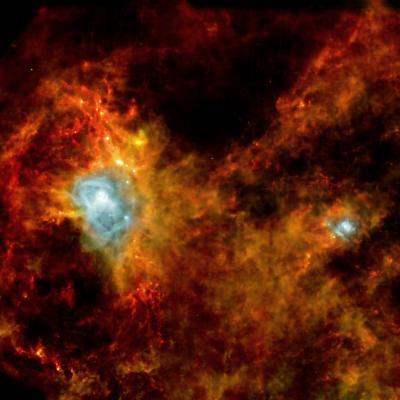The high sensitivity of the telescope allowed it to penetrate through clouds of dust that until now hid the approximately 700 stars being born there at that moment

The Herschel Space Telescope peered into the hidden celestial maternity home, revealing surprisingly high levels of activity. It is estimated that about 700 nascent stars are huddled in dust fibers visible in the image he took. GAnd is also the first photo on OSHI, the online display site for photos from Marshall.
The image shows a black cloud about 1000 light-years away in the constellation Aquila, the Eagle. It covers an area that spans 65 light years and is so full of dust that no infrared satellite has ever been able to look into the area. Now, thanks to Herschel's high sensitivity to extremely long infrared light rays, astronomers have obtained the first image of the inner region of the cloud.
The image was taken at 24 o'clock using Herschel's advanced instrumentation: the Photon Sensor Array Camera (PACS), and the Photometric and Spectral Image Input (SPIRE). The two bright areas in the image are areas where newly born stars make the hydrogen gas glow.
The new OSHI website will become a library of Herschel's most successful photos. Stunning views of the infrared sky will be uploaded to the site when the mission is complete, and will be available for use by media, educators and the general public.
In the picture you can see 700 condensed balls of gas and dust, embedded in the cloud. The condensations will eventually become stars. Astronomers estimate that about 100 of them are in the final stage of formation. In each of them, nuclear fusion will occur in its core, and thus it will become a real star. All the other 600 are in the process of developing protostars, but these too will eventually become a new generation of stars.
The cloud is part of the Gold Belt region, a huge ring of stars that circle the night sky - the solar system happens to be in the center of the belt. The first to notice this is John Herschel, the 19th century Englishman, after whom the European Space Agency's Herschel telescope was named. But it was Benjamin Gould who brought the news about the ring to the general public in 1874.
The Gold Belt creates bright stars for many constellations such as Orion, Scorpius, Cross, and is a region of star formation that astronomers can study. Observing this celestial nursery is essential information for Herschel, who aims to reveal the demographics of star formation and origin, or in other words, the quantities and mass range of these new stars. Besides the Eagle region, Herschel targeted 14 other star formation regions as part of the Gold Belt exploration program.

3 תגובות
For a deer, first of all, 1000 light years is not much, stars take much longer to form, so even in 1000 years it will be correct to say that they are being formed right now.
In addition, according to the theory of relativity, for any event that is outside the cone of light, it is not possible to determine what preceded what.
I didn't understand what was meant at the moment
I understand that it has already been impressed for a long time because the light takes time to arrive
I recommend going to the link at the end of the first paragraph of the article, clicking on the small square that represents the location of the image (thus getting the image seen here, in the body of the article)
http://oshi.esa.int/#detail=image.html?id=17
and choose the original magnification from the magnification options:
Available Downloads
Original size
1930px x 1930px (1490.148 KB)
pleasure is guaranteed.